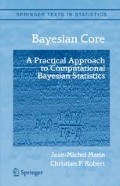This chapter deals with a special case of survey models. Surveys are used in many settings to evaluate some features of a given population, including its main characteristic; that is, the size of the population. In the case of capture–recapture surveys, individuals are observed either once or several times and the repeated observations can be used to draw inference on the population size and its dynamic characteristics. Along with the original model, we will also introduce extensions that are a first entry into hidden Markov chain models, detailed further in Chapter 6. In particular, we cover the generic Arnason–Schwarz model that is customarily used for open populations.
On the methodological side, we provide an entry into the accept–reject method, which is the central simulation technique behind most standard random generators and relates to the Metropolis–Hastings methodology in many ways.
Access this chapter
Tax calculation will be finalised at checkout
Purchases are for personal use only
Preview
Unable to display preview. Download preview PDF.
Rights and permissions
Copyright information
© 2007 Springer Science+Business Media, LLC
About this chapter
Cite this chapter
(2007). Capture–Recapture Experiments. In: Bayesian Core: A Practical Approach to Computational Bayesian Statistics. Springer Texts in Statistics. Springer, New York, NY. https://doi.org/10.1007/978-0-387-38983-7_5
Download citation
DOI: https://doi.org/10.1007/978-0-387-38983-7_5
Publisher Name: Springer, New York, NY
Print ISBN: 978-0-387-38979-0
Online ISBN: 978-0-387-38983-7
eBook Packages: Mathematics and StatisticsMathematics and Statistics (R0)

